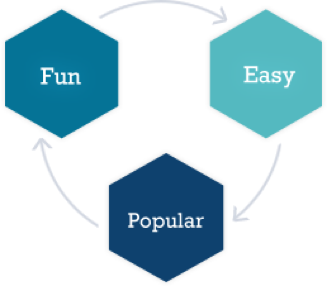
Categories:
If you’ve ever tried to change either your own behavior or someone else’s behavior – from potty-training a toddler to helping a friend lose weight – you know that it’s incredibly difficult. Old habits die hard, as they say, and inspiring others to create positive change can be an uphill battle. Luckily, we have decades of social marketing research helping us to sort out which types of messaging, marketing tools, and communication strategies are most effective at inspiring change. Here, we’ve laid out a basic plan for creating change via strategic behavior change marketing.
Target Audience Identification
The first, and arguably most important step in any behavior change marketing campaign is identifying and understanding the target audience. Different types of people behave in different ways, are influenced in different ways, and they can be reached in different ways as well. Understanding who your target audience is, both from a demographic (age, gender, location) and psychographic (attitudes and interests) perspective is critically important in developing a successful campaign.
One of the most widely used strategies for target audience segmentation is called persona development. With persona development, marketers use known or inferenced characteristics about their target audience to segment them into groups, often characterized by a fictional person, or persona. These personas don’t represent one specific person, but rather a group of people who have similar attitudes, interests and characteristics. These personas are then used to help determine which messages are deployed to which audience, and via which media for maximum results.

Qualitative and quantitative research is another way to identify and understand the target audience. Data from IDIs (in depth interviews), focus groups, and quantitative phone and internet research allows marketers to verify (or dispute) their assumptions about a specific audience segment, and can be incredibly helpful in narrowing messaging and interventions to only those most effective.
Example scenario
Let’s imagine how this would work for an organization whose goal is to increase consumption of fruits and vegetables among low-income mothers. The first thing they do is conduct focus groups and online research to understand the barriers that the moms face – why don’t they consume fruits and vegetables? What gets in the way? What is the competition for those food dollars? They use the information to segment their audience into a number of groups – moms lacking resources, moms unsure of how to prepare the food, and moms who just don’t understand the benefits. They would then create a persona for each of these groups. For example, ‘No Cook Natalie’ is a young 18- to 34-year old who doesn’t cook at all. She typically has a full-time, low-paying job and relies on fast food and/or prepared food to feed her family. The organization could then use this information to tailor their messaging to Natalie and all those like her. Perhaps they create easy recipes, complete with simple directions and shopping lists to help build Natalie’s pride in being able to make a meal herself.
Message Development
Another key tenant of behavior change marketing is crafting the right message for the target audience. Most people cannot be “convinced” to change their behavior – rather, they need to be motivated to change on their own. The key to motivating a target audience is understanding what’s in it for them – what matters to them enough to make a change? The next step is figuring out how to make the desired behavior appear fun, easy, and popular.

Two popular methods for identifying the most effective messaging are focus groups and A/B testing. Focus groups are fairly straightforward. A series of messages are developed by the marketer, then, a group of people that fit the target audience description are shown each of the messages and asked for their reaction. The messages that perform the best in the focus groups are then selected for use in the primary campaign.
If focus groups aren’t available, another message development tactic is to employ A/B testing. In this method, marketers craft two or more messages and run simultaneous campaigns, one with each message. Campaign performance is then measured and stacked against each other to determine which message set was more effective.
Example scenario
In our example scenario of a campaign to encourage consumption of fruits and vegetables, the marketers could use A/B testing to figure out which messages resonate best with their persona, No Cook Natalie. Perhaps they run two simultaneous Facebook campaigns targeting people who seek easy recipes as well as those interested in bargain shopping. One campaign ad has a headline that says, “Dinner in just 15 minutes” with an image of a happy mom putting a steaming bowl of pasta in front of two young children. The other ad appeals to a different insight, and has the headline “Want to be a better mom?.” The campaigns would run for the same length of time with the same targeting, and at the end of the month, the marketers would compare the campaign performance and determine which message had a higher click-through and conversion rate. The best performing message set would then be used in the rest of the campaign materials.
Outreach
Coming up with the right message is a big part of behavior change marketing – but it’s not the only part. Creating meaningful behavior change requires developing messaging and interventions that offer the target audience the exchange needed to assist with adopting the desired behavior (make it fun, easy and popular!). Tactics that may be part of the integrated approach to reach your target audience include social media, print, broadcast, display and programmatic advertising, public relations, email, direct mail, live events and more.

Social media is perhaps the most agile and affordable outreach tactic, appropriate for a wide variety of target audiences. Platforms including Facebook, Twitter, Instagram, Snapchat, Pinterest, and others provide both organic and paid opportunities for marketers to engage their target audience with a specific message, or continue an ongoing dialogue.
Similarly, print and broadcast media provide an excellent way to reach a large audience quickly, however, the targeting capabilities are much more limited, and the cost is typically significant.
Digital advertising, both display and programmatic, is another affordable and highly targeted method of reaching a specific target audience. One major advantage of digital advertising is its inherent measurability. It’s also easier to change out digital campaign messages than it is with other outreach tactics, such as print or broadcast.

Public Relations is often an important tactic for behavior change marketing campaigns, and can be very powerful in helping to make desired behaviors appear popular (remember – fun, easy, and popular are key!). While PR doesn’t require the significant media dollars that other outreach methods do, it does require some funding and an investment of time to prepare press releases, engage reporters, and work to keep the earned media on message.
Email and direct mail are two additional strategies for reaching a specific target audience. A couple of limitations to note are that some target audiences (particularly low- income populations) can be difficult to reach via direct mail due to unstable housing situations and lack of permanent addresses. Email can help to solve this problem; however, marketers will need a strategy for obtaining valid and relevant email addresses.
Last, but certainly not least, live events are a very powerful behavior change outreach tactic that provide marketers with the opportunity to engage their target audience directly. Live events tend to be more memorable, highly effective, and are often newsworthy – sparking additional earned media coverage. However, they also come with a significant price tag, are labor-intensive, and typically are only able to reach a small number of target audience members at a time.
Example scenario
In the campaign example described above, outreach tactics might include social media ads on Facebook or Snapchat (platforms that are popular among young moms) or a public relations campaign highlighting the positive changes that occurred for families who have begun eating more fruits and vegetables. Programmatic testimonial ads could target moms, reinforcing that they too can make these positive changes. The type and number of outreach tactics utilized will depend on the target audience, budget and campaign objectives.
Evaluation
In order to affect real behavior change, messaging needs to remain consistent over time and on every platform, encouraging and reinforcing positive behaviors. Behavior change is not a quick fix, it only happens over time. Specialty tactics like CRO (conversion rate optimization) and retargeting can be used to keep the message consistent and relevant over time. A conversion rate optimized landing page can help increase results while reducing marketing spend, and retargeting (targeting previous website visitors with display or social ads) can assist in reaching “warm leads” – i.e. those who have shown some interest in the campaign, but haven’t yet made the desired behavior change or conversion.
Outreach methods should also be continually evaluated in order to discern which tactics are most effective, and should receive the bulk of the resources. Depending on the type of outreach method used, various evaluation tactics may be appropriate, including conversion tracking, qualitative and quantitative research, cost per click, media pickup, social shares and more.

Example scenario
For our fictional campaign, we might use retargeting to reach people who clicked on a Facebook ad, but didn’t sign up for the online newsletter, or download a recipe. We might also employ conversion rate optimization to increase the likelihood that someone who visits the landing page downloads the recipe and the shopping list.
Later, we could use conversion tracking to determine how many people downloaded our materials – and measure cost per click to figure out which social media ads were most cost-effective in delivering visitors to the landing page.
Bringing it together
Behavior change is never easy – but with the right tools, and a defined strategy, it is possible. Remember, a successful behavior change marketing strategy always starts with careful target audience identification and segmentation, followed by message development, outreach, and finally, evaluation.
For more tips about creating successful Behavior Change Marketing campaigns, check out Behavior Change Marketing: 8 Tips to Inspire Action or download our Behavior Change Marketing Best Practices Checklist.
About Ethos
Ethos is a multiplatform branding agency that develops and executes integrated marketing campaigns across multiple channels for companies inside and outside of Maine.
At Ethos, we believe that the most effective way to set a company’s marketing course is by finding its core truth – its ethos. We know that once we discover and communicate that core truth, we can truly make a difference for each client’s unique marketing and business objectives.
With Ethos, you get more than a behavior change marketing agency. You get a long-term partner whose goals are your goals.
Learn more about the Ethos approach and the work we’ve done for our clients. Want to have a conversation about your brand’s core truth? Contact us!

